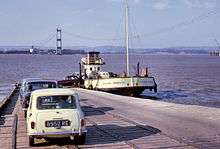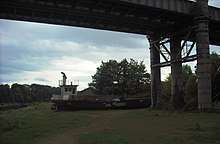Aust Ferry
Aust Ferry or Beachley Ferry was a ferry service that operated across the River Severn between Aust and Beachley, both in Gloucestershire, England. Before the Severn Bridge opened in 1966, it provided service for road traffic crossing between the West Country and South Wales. The nearest fixed crossing was a 60-mile (97 km) round trip to Gloucester.
 A ferry arrives at Aust in Gloucestershire, England in 1964. The Severn Bridge is under construction in the background | |
| Industry | Passenger and freight transportation |
|---|---|
| Fate | Superseded by Severn Bridge |
| Founded | 1829 Car ferry 1926 |
| Founder | Duke of Beaufort Old Passage Ferry Association |
| Defunct | 8 September 1966 |
Area served | River Severn |
The ferry ran from a pier at Old Passage near the village of Aust on the east bank of the Severn. It ran to a similar pier on the east of the Beachley peninsula.[1] The car ferry, set up in 1926, only carried cars, pedestrians and motorcycles; goods vehicles were prohibited from accessing the ferry terminal.[2]
History
There has been a passage across the Severn at this location since Roman Britain. It has been recorded the site of the Trajectus (throwing-across) where the Roman legions used to be ferried across the Severn.[3] It was recorded in the 12th century when the de Clares, lords of Tidenham, granted quittance of the passage to the monks of Tintern.[4] It was evidently much used in 1405 when great numbers of the English and Welsh were said to resort to the nearby chapel of St. Twrog. The manor of Tidenham retained rights over the passage, and received rents from the parishes of Aust and Beachley, until the 19th century.[5]
The journey, a distance of over a mile at a point where the tides run swiftly, was a dangerous one, and its reputation, the roughness of the water, and the smallness of the boats deterred travellers. Daniel Defoe visited the crossing from the Aust side in the 18th century, but did not trust the ferry to survive the bad weather, and elected to go via Gloucester instead.[6] By that time, ferry crossings from New Passage, between Redwick near Pilning and Sudbrook on the Welsh side, rivalled the Aust passage, which became known as the Old Passage.[7]
Steam ferries: 1827–1860
In 1825 a new era opened with the formation of the Old Passage Ferry Association, sponsored by the Duke of Beaufort, as Lord of Tidenham.[8] The company built stone piers on both banks, and commissioned a steamboat which began to ply in 1827, with a second one five years later, although sailing boats also continued to be used. By virtue of these improvements the company achieved the transfer of most of the cross-Severn mail routes from the rival New Passage.[5] However, the passage remained dangerous. The Beachley-Aust ferry was lost with all hands on 1 September 1839. The same thing happened on 12 March 1844; the master, James Whitchurch was the son of the captain lost in 1839.[9]
In 1863, the railway reached the downstream, New Passage shores on both sides of the river, and this became the standard route. The Old Passage, not connected to the railway, therefore lost much of its traffic. The advent of railways, in particular the opening of the Bristol and South Wales Union Railway in 1864, the Severn Railway Bridge in 1879 and then the Severn Tunnel in 1886, brought a sharp decrease in traffic. Both the steamboats were scrapped by 1860 and eventually the service was closed altogether.[5]
Car ferry: 1926–1966


The ferry service gained a new lease of life, however, with the growth of motor traffic, and a service was re-opened in 1926. Between 1931 and 1966, a ferry service was operated by Enoch Williams of the Old Passage Severn Ferry Company Ltd.[10] Initially, this was only able to transport passengers with bicycles and motorbikes, but, by 1934, the Severn Queen was launched as a car ferry. It was able to carry just 17 cars. Each car had to turn sharply off the ramp onto the ferry, then be turned on a manually operated turntable before being parked. The process was reversed for unloading.[11] The ferry timetable was affected by the huge tidal range on the Severn and it was unable to operate at low tide or at very high tides. There was also a reported engine breakdown where the ferry took two hours to repair whilst drifting all the time down the Bristol Channel with the outward tide, and after the engine was repaired it took hours to return to Aust. The last ferry crossing occurred on 8 September 1966,[12] the day before the first Severn Bridge opened.

The Martin Scorsese film No Direction Home about the life of Bob Dylan uses the Barry Feinstein photograph of Dylan standing in front of the Aust ferry terminal in May 1966, not long before it ceased operation.[13]
As late as 2007, several older road signs around central Bristol showed directions to "Aust Ferry", but with the word "ferry" painted out.[14]
Vessels

- MV Princess Ida (built Chepstow, 1931). Wooden. Withdrawn 1935.
- MV Severn Queen (built Chepstow, 1934). Wheelhouse and funnel in centre of car deck. Withdrawn 1966.
- MV Severn King (built Beverley, Woodward & Scarr (Yorkshire), 1935). Similar to the Severn Queen but wheelhouse elevated over car deck, originally a single funnel but twin side funnels a later addition. Withdrawn 1966. In 1970 this boat was in use to support the demolition of the damaged Severn Railway Bridge, when it collided with one of the bridge piers and was sunk.[15][16]
- MV Severn Prince (built Yorkshire Dry Dock, Hull, 1959). Wheelhouse and funnel in centre of car deck. Withdrawn 1966.
MV Severn Princess restoration
The last remaining ferry boat, the Severn Princess which was launched in 1959, was found wrecked, abandoned and full of fertiliser in Ireland in 1999 by Dr. Richard Jones, the grandson of Enoch Williams. As Galway County Council had put a demolition order on the vessel, a small group of Chepstow residents formed the Severn Princess Restoration Group with an urgent remit to save the Severn Princess and return her to the town.
The derelict vessel was purchased for a token one guinea and temporary repair work started to get the vessel to a state where it could be towed back to South Wales.
The Severn Princess returned to Beachley in 2003 following a five-day tow. For some years the vessel rested alongside the Beachley slipway,[17] but was eventually moved to the west bank of the River Wye in Chepstow, to sit beneath the railway bridge.[18] After some years of delay, during which the condition of the vessel deteriorated further, restoration finally started in 2014.[19]
The first stage of the restoration was made possible with the pledge and realisation of support from Chepstow-based steel bridging and infrastructure manufacturer Mabey Bridge Ltd which, as part of its Bridging Time community support programme, donated time, equipment and paint to enable the stabilisation of the vessel and arrest further deterioration. Mabey Bridge apprentices along with other employees of the company removed the turntable, winch and wheel capstan from the ferry and relocated them to the Mabey Bridge manufacturing facility for refurbishment. The majority of spray guards were similarly removed and relocated. However, some have been left as a template for future rebuilding. Holes were also drilled in the lower hull to drain the ferry of rainwater and Mabey Bridge staff secured the cabins. The winch chain hull tears were sent to be plated.
This first phase of restoration was completed Thursday 11 September 2014 and commemorated with a handover ceremony attended by the Mayor of Chepstow Cllr Ned Heywood, members of the Severn Princess Restoration Group, and management and apprentices from Mabey Bridge Ltd.
The long term aim of the Severn Princess Restoration Group is to return the vessel to a state where it can sit as a permanent heritage display at the site. The group has begun the process of clearing the area under the Brunel (tubular) railway bridge to make the site more attractive to visitors and users of the Wales Coast Path, which runs through Chepstow.
See also
References
- 7th Series Sheet 156 : Bristol and Stroud (Map). Ordnance Survey. 1952. Retrieved 8 November 2014.
- "The Gloucestershire County Council (Roads in the Parish of Almondsbury, Alveston, Aust, Olveston and Redwick (Restriction) (Amendment) (No 2) Order 1965". London Gazette: 3387. 25 March 1966. Retrieved 8 November 2014.
- Wilson, John, Imperial Gazetteer, 1870-72
- "Ferries across the Severn". BBC News. 4 August 2009. Retrieved 8 November 2014.
- Morgan, Kathleen; Smith, Brian S (1972). "Victoria County History: Gloucestershire: Vol 10 – Tidenham including Lancaut: Introduction". British History Online. University of London. Retrieved 22 February 2020.
- Defoe, Daniel (1734). Curious and diverting journies, thro' the whole island of Great-Britain. G. Parker. p. 246.
- "Old Passage Ferry". Post Office Report. 1842: 39. Retrieved 8 November 2014. Cite journal requires
|journal=(help) - "Aust Bridge". London Gazette: 6921. 29 November 1845.
- 1844 ferry loss
- Jordan, Severn Enterprise
- Car ferry
- Fells, Maurice (6 July 2015). The Little Book of Bristol. The History Press. ISBN 978-0750961950.
- Bob Dylan
- "Surviving road sign to the old ferry". 2007.
- Jordan (1977), pp. 92–93,95–96.
- Huxley, Ron (1984). The rise and fall of the Severn Bridge Railway. pp. 144–148. ISBN 978-1-84868-033-3.CS1 maint: ref=harv (link)
- "Photos of the returned Severn Princess at Beachley". 2007.
- "Ferrytale ending for the Princess". This is Gloucestershire. 13 August 2009. Archived from the original on 5 May 2013.
- "Severn Princess car ferry restoration begins". BBC News: Gloucestershire. BBC. Retrieved 1 July 2014.
Further reading
- Jordan, Christopher (1977). Severn Enterprise. Arthur H Stockwell. ISBN 0-7223-0967-8.
- Greeves, John (September 2012). "Return of the Princess". Vintage Roadscene. Key Publishing. ISSN 0266-8947.
- Lee, Jean (2000). Born an Optimist. M.I.P.I. publishing. ISBN 9780954055905.
External links
| Wikimedia Commons has media related to Aust ferry. |